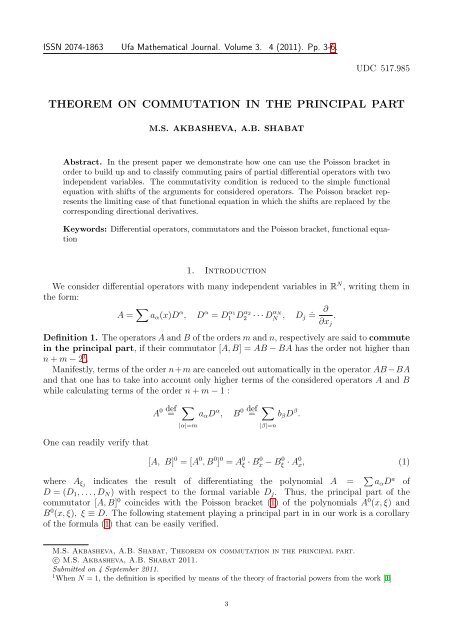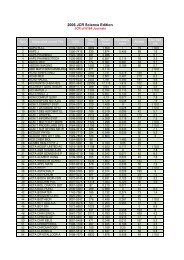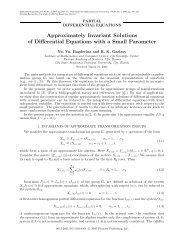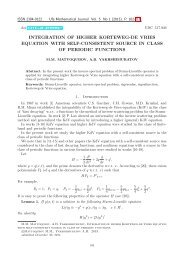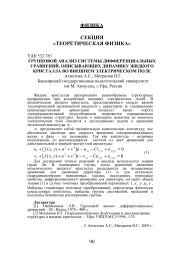THEOREM ON COMMUTATION IN THE PRINCIPAL PART
THEOREM ON COMMUTATION IN THE PRINCIPAL PART
THEOREM ON COMMUTATION IN THE PRINCIPAL PART
You also want an ePaper? Increase the reach of your titles
YUMPU automatically turns print PDFs into web optimized ePapers that Google loves.
ISSN 2074-1863 Ufa Mathematical Journal. Volume 3. 4 (2011). Pp. 3-6.<br />
UDC 517.985<br />
<strong><strong>THE</strong>OREM</strong> <strong>ON</strong> COMMUTATI<strong>ON</strong> <strong>IN</strong> <strong>THE</strong> PR<strong>IN</strong>CIPAL <strong>PART</strong><br />
M.S. AKBASHEVA, A.B. SHABAT<br />
Abstract. In the present paper we demonstrate how one can use the Poisson bracket in<br />
order to build up and to classify commuting pairs of partial differential operators with two<br />
independent variables. The commutativity condition is reduced to the simple functional<br />
equation with shifts of the arguments for considered operators. The Poisson bracket represents<br />
the limiting case of that functional equation in which the shifts are replaced by the<br />
corresponding directional derivatives.<br />
Keywords: Differential operators, commutators and the Poisson bracket, functional equation<br />
1. Introduction<br />
We consider differential operators with many independent variables in R N , writing them in<br />
the form:<br />
A = ∑︁ a α (x)D α , D α = D α 1<br />
1 D α 2<br />
2 · · · D α N<br />
. ∂∂<br />
N<br />
, D j = .<br />
∂∂x j<br />
Definition 1. The operators A and B of the orders m and n, respectively are said to commute<br />
in the principal part, if their commutator [A, B] = AB − BA has the order not higher than<br />
n + m − 2 1 .<br />
Manifestly, terms of the order n+m are canceled out automatically in the operator AB −BA<br />
and that one has to take into account only higher terms of the considered operators A and B<br />
while calculating terms of the order n + m − 1 :<br />
One can readily verify that<br />
A 0 def<br />
= ∑︁<br />
|α|=m<br />
a α D α ,<br />
B 0 def<br />
= ∑︁<br />
|β|=n<br />
b β D β .<br />
[A, B] 0 = [A 0 , B 0 ] 0 = A 0 ξ · B 0 x − B 0 ξ · A 0 x, (1)<br />
where A ξj indicates the result of differentiating the polynomial A = ∑︀ a α D a of<br />
D = (D 1 , . . . , D N ) with respect to the formal variable D j . Thus, the principal part of the<br />
commutator [A, B] 0 coincides with the Poisson bracket (1) of the polynomials A 0 (x, ξ) and<br />
B 0 (x, ξ), ξ ≡ D. The following statement playing a principal part in in our work is a corollary<br />
of the formula (1) that can be easily verified.<br />
M.S. Akbasheva, A.B. Shabat, Theorem on commutation in the principal part.<br />
c○ M.S. Akbasheva, A.B. Shabat 2011.<br />
Submitted on 4 September 2011.<br />
1 When N = 1, the definition is specified by means of the theory of fractorial powers from the work [1]<br />
3
4 M.S. AKBASHEVA, A.B. SHABAT<br />
Lemma 1. Let us assume that the operators A, B have the following form<br />
A = e α·x · a(D), B = e β·x · b(D), (2)<br />
where a(D) and b(D) are polynomials with constant coefficients and α, β are arbitrary vectors<br />
in C N . Then commutation in the principal part is reduce to the following condition on the<br />
principal parts of these polynomials :<br />
∂∂ β log a 0 = ∂∂ α log b 0 , (3)<br />
where ∂∂ α and ∂∂ β denote derivatives in the direction of the vectors α and β, respectively.<br />
For example, in the case N = 2 of two independent variables x = (x 1 , x 2 ), and we have<br />
Equation (2) is written in the form<br />
A = e α 1x 1 +α 2 x2<br />
· a(D 1 , D 2 ), B = e β 1x 1 +β 2 x2<br />
· b(D 1 , D 2 ).<br />
(β 1 ∂∂ ξ1 + β 2 ∂∂ ξ2 ) log P (ξ 1 , ξ 2 ) = (α 1 ∂∂ ξ1 + α 2 ∂∂ ξ2 ) log Q(ξ 1 , ξ 2 ), (4)<br />
where for the sake of clarity another notation ξ j ≡ D j is introduced for formal variables.<br />
Equation (3) is differentiated with respect to the latter variables:<br />
P (ξ 1 , ξ 2 ) = a 0 (ξ 1 , ξ 2 ), Q(ξ 1 , ξ 2 ) = b 0 (ξ 1 , ξ 2 ).<br />
Obviously, the Poisson bracket (1) equals to zero, i.e. commutation in the principal part is<br />
only a necessary condition for vanishing of the commutator [A, B] = 0. For the considered<br />
operators of the form (6), the commutativity criterion for operators can be written in the form<br />
of a functional equation in the polynomials a(ξ) and b(ξ) corresponding to them:<br />
a(ξ + β)b(ξ) = a(ξ)b(ξ + α). (5)<br />
This equation follows from the below formula for composition of operators (2), considered in<br />
Lemma 1:<br />
A ∘ B = e α·x a(D) ∘ e β·x b(D) = e (α+β)·x a(D + η)b(D).<br />
2. Interaction of Equations<br />
Our aim is to verify the hypothesis that Equation (3) is sufficient classify commuting pairs<br />
of operators of the form (2). In other words, we are dealing with the Poisson bracket and<br />
quantification problems related to it in quite a special class of differential operators.<br />
2.1. The case N = 2. Let us represent the considered operators in the following form,<br />
assuming that the vectors α and β in (2) are linearly independent:<br />
Then, Equation (5) is written in the form<br />
A = e x · a(D x , D y ), B = e y · b(D x , D y ). (6)<br />
a(ξ, η + 1)b(ξ, η) = a(ξ, η)b(ξ + 1, η). (7)<br />
Equation (7) has the following corollary.<br />
Lemma 2. The commutativity conditions (7) for the operators (6) are not violated when<br />
multiplying the polynomials a(ξ, η) and b(ξ, η) by ξ i and η j , respectively, or with simultaneous<br />
multiplication of these polynomials by the power ξ + η.<br />
Example 1. By virtue of Lemma 2 we have:<br />
A = e x D i x(D x + D y ) k , B = e y D j y(D x + D y ) k ⇒ AB = BA. (8)<br />
The following example, where the operator A is of the first order and the order of B is<br />
arbitrary, demonstrates that commuting pairs are not exhausted by the formula (8).
<strong><strong>THE</strong>OREM</strong> <strong>ON</strong> COMMUTATI<strong>ON</strong> <strong>IN</strong> <strong>THE</strong> PR<strong>IN</strong>CIPAL <strong>PART</strong> 5<br />
Example 2. Using the functional equation (7), one can readily verify commutation of the<br />
operators<br />
A = e x (D x + nD y ), B = e y (D x + nD y )(D x + nD y + 1) · · · (D x + nD y + n − 1). (9)<br />
Note that the triangular change of independent variables<br />
x = ˆx, y = nˆx + ˆy ⇒ D^x = D x + nD y (10)<br />
reduces the operators to a ”one-dimensional form” 1 from the work [3]:<br />
ˆA = e x D x , ˆB = e y e nx D x (D x + 1) · · · (D x + n − 1).<br />
Using the work [3] cited above (see also [2]), one can extend the series (9) to the operators<br />
A of the second order as follows.<br />
Example 3. Let X = 2D x + nD y , n ≥ 2, then the operators<br />
A = e x · X · (X + 1), B = e y · X · (X + 1) · · · (X + n − 1)<br />
commute. In particular, when n = 5,<br />
B = e y (2D x + 5D y )(2D x + 5D y + 1) · · · (2D x + nD y + 4).<br />
Similarly to the previous example, the substitution<br />
x = 2ˆx, y = nˆx + ˆy ⇒ D^x = 2D x + nD y , (11)<br />
reduces the considered series to a one-dimensional case.<br />
In general, the problem on commuting operators (6) is reduced to the problem considered<br />
in the work [3] by means of the Adler Lemma from [4]. This lemma claims that polynomial<br />
solutions of the functional equation (7) are reducible 2 and a separated to linear multipliers of<br />
the form αD x + βD y + γ. One can readily observe that the triangular substitutions of the<br />
form (11), (10), together with Lemma 2 formulated above, allow us to reduce the order of the<br />
considered operator A and, finally, to reduce it to a one-dimensional form (cf. Example 2).<br />
Obviously, similar transformations are applicable to solutions of the corresponding equation<br />
(4) as well, which is much simpler than Equation (7). All these gives us a possibility to make a<br />
complete classification of the list of commuting pairs (6), where the operator A is of the second<br />
order, and the order of the operator B is not higher than 5 (see [3]) and compare it to the<br />
similar list of solutions of Equation (4). As a result of this comparison, we become sure that<br />
the lists coincide and generalizing, we formulate the following hypothetical theorem.<br />
Theorem*. When N = 2, all solutions of the equation (cf. (4)):<br />
∂∂ η log P (ξ, η) = ∂∂ ξ log Q(ξ, η)<br />
generate the commuting operators (6) with P = a 0 , Q = b 0 .<br />
Together with elaboration of various approaches to the proof of the statement formulated above,<br />
it seems promising to investigate the connection of factorization of one-dimensional operators<br />
from [3] with the factorization formula of a homogeneous polynomial P (ξ, η) :<br />
P (ξ, η) = const η m<br />
m<br />
∏︁<br />
j=1<br />
(z − z j ), z = ξ η ,<br />
corresponding to the operator A of the form m. In conclusion of this section we provide two<br />
other commuting pairs of the operators A and B in addition to Lemma 2 and Examples 1–3:<br />
A = e x (D x + 2D y ) 2 ; B = e y (D x + 2D y ) 2 (D x + 2D y + 1) 2 ; (12)<br />
A = e x X · Y, X = D x + 2D y , Y = D x + 3D y ; B = e y X(X + 1)Y (Y + 1)(Y + 2). (13)<br />
1 The former notation is preserved for the new variables.<br />
2 This is the specific character of the case N = 2.
6 M.S. AKBASHEVA, A.B. SHABAT<br />
In the first case, the triangular substitution reduces the operator A to a one-dimensional one,<br />
and in the second case, the substitution<br />
{︃<br />
{︃<br />
x = ˆx + ˆy<br />
D^x = D x + 3D y<br />
⇒<br />
.<br />
y = 3ˆx + 2ˆy D^y = D x + 2D y<br />
reduces the pair (13) to the case of separating variables:<br />
A = A 1 · A 2 , [A 1 , A 2 ] = 0, B = A 3 1A 2 2, A 1 = e x D x , A 2 = e y D y .<br />
2.2. The case N > 2. The problem of classifying polynomials satisfying the functional<br />
equation (5) and its Corollary (3) when N > 2 remains open so far. In the simplest case of<br />
second-order operators and N = 3:<br />
A = e x · a(D x , D y , D z ), B = e y · b(D x , D y , D z ),<br />
Equation (3) is reduced to the following system of algebraic equations for 12 coefficients of<br />
homogeneous polynomials P (ξ, η, ζ) = a 0 (ξ, η, ζ), Q(ξ, η, ζ) = b 0 (ξ, η, ζ):<br />
P = a 1 ξ 2 + a 2 ξη + a 3 ξζ + a 4 η 2 + a 5 ηζ + a 6 ζ 2 , Q = b 1 ξ 2 + b 2 ξη + · · · + b 6 ζ 2 ,<br />
2a 1 b 1 = b 1 a 2 , a 4 b 2 = 2a 4 b 4 , a 6 b 3 = a 5 b 6 , a 1 b 2 + 2a 2 b 1 = 2a 4 b 1 + a 2 b 2 (22 1 )<br />
a 1 b 3 + 2b 1 a 3 = b 1 a 5 + a 2 b 3 , a 2 b 2 + 2a 4 b 1 = 2a 4 b 2 + a 2 b 4 , a 3 b 3 + 2a 6 b 1 = b 3 a 5 + b 6 a 2 (22 2 )<br />
a 2 b 3 + a 3 b 2 + 2a 5 b 1 = b 2 a 5 + 2b 3 a 4 + b 5 a 2 , a 4 b 3 + a 5 b 2 = b 4 a 5 + 2b 5 a 4 (22 3 )<br />
variant : b 1 = a 4 = 1, a 5 b 3 + a 6 b 2 = b 5 a 5 + 2b 6 a 4 (22 4 )<br />
In case of the general condition b 1 a 4 ≠ 0, this system provides a two-parameter system:<br />
P = Q = (ξ + η) 2 + α(ξ + η)ζ + λαζ 2 = (ξ + η + β 1 ζ)(ξ + η + β 2 ζ)<br />
of solutions to Equation (3) and the corresponding commuting operators<br />
A = e x (D x + D y + β 1 D z )(D x + D y + β 2 D z ), B = e y−x A. (2.14)<br />
Imposing additional conditions on the parameters β j , one can obtain the third operator C of<br />
the form (2), commuting with (2.14).<br />
BIBLIOGRAPHY<br />
1. I. Schur Uber vertauschbare lineare Differentialausdrucke // Sitzungsber. Berliner Math. Gen.<br />
1905. 4. P. 2–8.<br />
2. J.L. Burchnall, T.W. Chaundy Commutative ordinary diff. operators, II. The identity P n = Q m<br />
// Proc. Roy. Soc. London, (A). 1932. 134. P. 471–485.<br />
3. Shabat A.B., Elkanova Z.S. On commuting differential operators // TMF. 2010. V. 162, 3.<br />
P. 334–344. In Russian.<br />
4. Shabat A.B., Elkanova Z.S. On commutativity conditions of differential operators // UMJ. 2011.<br />
V. 3, 2. P. 91–99.<br />
Madina Salikhovna Akbasheva,<br />
Aliev Karachaevo-Cherkesiya State University<br />
369202, Karachaevsk, Lenin Str., 29, Russia<br />
E-mail: Haliy 0986@mail.ru<br />
Aleksey Borisovich Shabat,<br />
Aliev Karachaevo-Cherkesiya State University<br />
369202, Karachaevsk, Lenin Str., 29, Russia<br />
E-mail: Shabatab@mail.ru<br />
Translated from Russian by E.D. Avdonina.


